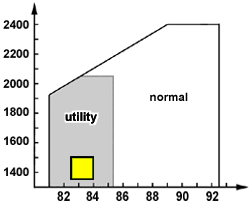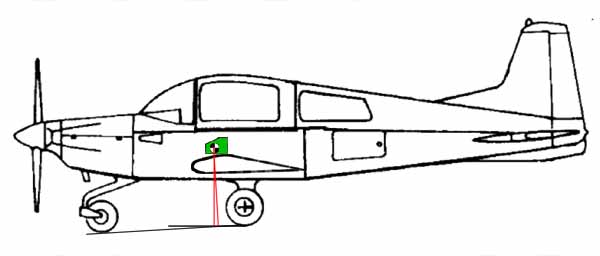 If you weigh your airplane, be sure it's level!
If you weigh your airplane, be sure it's level!
Pilots know we need a well-balanced airplane, but we don't always have a good grasp of how sensitive that concept can be. We know instinctively that there's a limit on weight, but what about the balance point?
If the center of gravity is too far forward, the elevator can't raise the nose for takeoff or the landing flare. Too far aft, and the plane may be unable to recover from a stall or spin. You'll find the safe operating envelope in the POH or flight manual, or there's a verbal description in the Type Certificate Data Sheet. Here's an example for a Grumman Tiger, a light four-place plane. The location of the envelope is superimposed below on an outline of the plane, to emphasize what a small fraction of real estate it occupies. Like most planes of its class, the Tiger's operating range is near the front seats. When the airplane is empty, its CG is near the forward edge of the envelope (the yellow area), ahead of the front seats. So, anything we put into the plane will shift the balance point toward the tail, and the forward location of the empty CG is an advantage.

All of the load stations are referred to the longitudinal axis, a useful reference for cruising flight. To measure them in the shop we level the airplane, which makes the longitudinal axis parallel to the floor. (We assume the floor is level!) Then we project our measurements onto the floor, either mathematically or by using a plumb bob.
Here's where a little bit goes a long way. In the example airplane, the CG is not on the hangar floor, it's about three feet above it. Imagine a plumb bob hanging from the CG of a level airplane. Now, let's raise the nose of that plane about 3° and see where the plumb bob goes. It will contact the floor almost two inches closer to the main wheels, as indicated by the red lines in the drawing above. This sounds trivial, but the mistake gives up 16% of that plane's envelope — enough to distort the calculation for a safe load to produce a result that's behind the aft limit. With such data, the pilot of that plane would be led to reject a load that was actually safe. Maybe that's not a bad thing, but it does reduce the usefulness of the airplane.
This analysis was inspired by a pilot whose mechanic weighed his plane by simply pullling it onto the scales without setting it level. As you can see on the outline diagram, the nose wheel is a few degrees lower than the mains when the plane is in level attitude. So that plane was slightly nose-up when it was weighed, and its empty CG was calculated two inches too far aft. This was confirmed when they re-weighed the airplane properly.